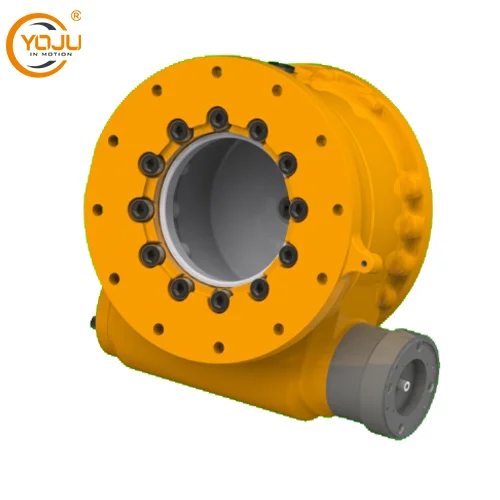As concentrated solar power (CSP) technology advances, the demand for highly reliable and accurate motion systems has never been greater. At the core of many solar tower systems lies the CSP-solar tower slewing drive, a specialized mechanism that ensures the precise positioning of heliostats to maximize energy capture. In this blog post, YOJU, a high performance custom slew drive manufacturing factory, will share the role of CSP-solar tower slewing drives for sale, its applications, etc.
Understanding the Role of CSP-Solar Tower Slewing Drive
In a solar tower plant, thousands of heliostats reflect sunlight onto a central receiver. To track the sun effectively throughout the day, each heliostat requires a motion control unit capable of both rotation and tilting. The solar tower slewing drive fulfills this function, combining worm gears, bearings, and sealing systems into a compact unit.
Unlike traditional actuators, slewing drives handle dual-axis movement with precision and high load capacity, enabling large mirrors to follow the sun seamlessly. Their engineering reduces backlash and wear, guaranteeing long-term operational stability in harsh desert environments where CSP plants are often located.
How Slewing Drives Enhance CSP Tower Efficiency?
The efficiency of a CSP plant depends largely on the accuracy of sun tracking. A slewing gear drive for CSP heliostats enables angular adjustments as small as fractions of a degree. This ensures reflected beams converge precisely on the central receiver, where thermal energy is concentrated for power generation.
Moreover, advanced slewing drive models integrate automation and feedback sensors, allowing real-time adjustments based on weather conditions and solar angles. This enhances energy yield and minimizes power loss, giving solar tower plants an edge over other renewable systems in terms of dispatchable electricity.
Engineering Design of Solar Tower Slewing Gearboxes
A solar tracking slewing gearbox is not just a mechanical unit but a highly engineered system designed to withstand extreme conditions. CSP installations often face:
-
High temperatures from reflected sunlight
-
Dust storms and sand erosion in desert locations
-
Heavy wind loads acting on large heliostat surfaces
To address these challenges, slewing drives are designed with sealed housings, corrosion-resistant coatings, and lubrication systems. Some manufacturers also employ hardened worm gears and specialized bearing races to improve durability. These engineering refinements extend service life and reduce maintenance intervals, critical for large-scale CSP projects with thousands of heliostats.

Application of CSP-Solar Tower Slewing Drive
While the CSP-solar tower slewing mechanism is central to heliostat motion, similar technology finds applications in other renewable sectors. Photovoltaic dual-axis trackers, parabolic trough concentrators, and even wind turbine yaw systems employ comparable slewing units.
This cross-industry adoption demonstrates the versatility of slewing drives. The innovations developed for CSP—such as compact worm gear integration and load-bearing enhancements—are now influencing broader renewable energy engineering.
Digital Integration and Intelligent Slewing Drive Systems
Modern solar tower slewing drive units are increasingly integrated with digital control platforms. By embedding IoT sensors, plant operators can monitor torque, vibration, and temperature data in real time.
This shift toward predictive maintenance ensures early detection of faults, minimizing downtime. Furthermore, digital slewing drives allow CSP operators to implement AI-driven heliostat alignment algorithms, boosting thermal efficiency across the solar field.
Global Market Outlook for CSP-Solar Tower Tracking Systems
The CSP industry is expanding across regions with strong solar resources, such as the Middle East, North Africa, China, and parts of the United States. With governments pushing for renewable energy diversification, the market demand for solar tower slewing drive assemblies is expected to grow steadily.
Manufacturers are competing to deliver slewing drives that balance cost, durability, and efficiency. At the same time, research is ongoing to develop lightweight materials and low-friction coatings, further optimizing performance. This positions slewing drive technology as a key enabler in scaling CSP capacity worldwide.
Environmental and Economic Impacts of Reliable Slewing Drives
The reliability of CSP heliostat slewing systems has far-reaching implications. Efficient tracking translates into higher solar-to-electricity conversion rates, reducing reliance on fossil fuels. Economically, longer-lasting slewing drives lower operational costs by minimizing maintenance cycles and replacement needs.
From an environmental perspective, a well-engineered slewing drive contributes to reduced carbon emissions and supports the broader goal of clean energy transition. It becomes clear that this seemingly small mechanical unit plays a disproportionately large role in advancing sustainable power generation.
Future Directions for CSP-Solar Tower Slewing Technology
Looking ahead, several innovations may shape the future of CSP-solar tower slewing drives:
-
Lightweight composite housings to reduce overall system weight.
-
Magnetic or hybrid gear systems for reduced friction and noise.
-
AI-optimized alignment algorithms integrated directly into the slewing unit.
-
Fully modular slewing designs allowing quick replacement in large solar farms.
These developments highlight how the slewing drive will continue evolving alongside global energy needs, making it a critical component in tomorrow’s solar infrastructure.
Conclusion:
The CSP-solar tower slewing drive is more than just a gearbox—it is a cornerstone of precision engineering in renewable energy. By enabling accurate heliostat tracking, resisting harsh conditions, and integrating with digital platforms, it ensures that solar towers operate at peak efficiency.
www.enyoju.com
YOJU

+ There are no comments
Add yours